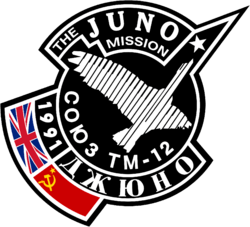Soyuz TM-12 facts for kids
| Mission duration | 144 days, 15 hours, 21 minutes, 50 seconds |
|---|---|
| Orbits completed | ~2,260 |
| Spacecraft properties | |
| Spacecraft type | Soyuz-TM |
| Manufacturer | NPO Energia |
| Launch mass | 7,160 kilograms (15,790 lb) |
| Crew | |
| Crew size | 3 |
| Members | Anatoly Artsebarsky |
| Launching | Sergei Krikalev Helen Sharman |
| Landing | Toktar Aubakirov Franz Viehböck |
| Callsign | Озо́н (Ozone) |
| Start of mission | |
| Launch date | 18 May 1991, 12:50:28 UTC |
| Rocket | Soyuz-U2 |
| End of mission | |
| Landing date | 10 October 1991, 04:12:18 UTC |
| Landing site | 61 kilometres (38 mi) SW of Arkalyk |
| Orbital parameters | |
| Reference system | Geocentric |
| Regime | Low Earth |
| Perigee | 389 kilometres (242 mi) |
| Apogee | 397 kilometres (247 mi) |
| Inclination | 51.6 degrees |
| Period | 92.4 minutes |
| Docking with Mir | |
| Docking date | 20 May 1991, 14:30:43 UTC |
| Undocking date | 9 October 1991, 20:55:08 UTC |

Soyuz programme
(Crewed missions) |
|
The Soyuz TM-12 mission was a space journey to the Mir space station. It was the 12th time a Soyuz spacecraft visited Mir. This mission was very special because it carried the first person from the United Kingdom to go into space, a woman named Helen Sharman.
Contents
Who Flew on Soyuz TM-12?
This section introduces the brave astronauts and cosmonauts who were part of the Soyuz TM-12 mission. They had different roles during their journey to space.
Meet the Launch Crew
The crew members who launched into space on Soyuz TM-12 were:
- Anatoly Artsebarsky: He was the Commander of the mission. This was his first and only spaceflight.
- Sergei Krikalev: He was the Flight Engineer. This was his second time flying to the Mir space station.
- Helen Sharman: She was the Research Cosmonaut. She was the first Briton in space and flew as part of a special project called Project Juno. This was her only spaceflight.
| Position | Launching crew | Landing crew |
|---|---|---|
| Commander | Only spaceflight |
|
| Flight Engineer | Second spaceflight |
Only spaceflight |
| Research Cosmonaut | Only spaceflight Project Juno |
Only spaceflight |
Who Returned to Earth?
Not all crew members who launch into space return on the same spacecraft. For Soyuz TM-12, the landing crew was different:
- Anatoly Artsebarsky: He stayed on Mir for a longer mission.
- Sergei Krikalev: He also stayed on Mir for a longer mission.
- Helen Sharman: She returned to Earth on a different Soyuz spacecraft after her short mission.
- Toktar Aubakirov: He was a cosmonaut from the Kazakh SSR who landed with the Soyuz TM-12 spacecraft.
- Franz Viehböck: He was an Austrian cosmonaut who also landed with the Soyuz TM-12 spacecraft.
What Happened During the Mission?
The Soyuz TM-12 mission had many important moments and experiments. The crew worked on various scientific tasks and experienced life in space.
Welcoming the New Crew to Mir
When the Soyuz TM-12 spacecraft arrived at the Mir space station, the crew already living there welcomed the new arrivals. This included Anatoli Artsebarski, Sergei Krikalev, and Helen Sharman. Sergei Krikalev was visiting Mir for the second time.
Helen Sharman's Experiments
Helen Sharman's journey was part of Project Juno. This was a special project partly paid for by British companies. Her main job was to do science experiments, especially in chemistry, which was her area of study.
Pansy Seeds in Space
One interesting experiment involved a bag of 250,000 pansy seeds. These seeds were placed in a part of the Mir station called the Kvant-2 EVA airlock. This area was not as protected from space radiation as other parts of Mir. Scientists wanted to see how the seeds would be affected.
Talking to Schools and Superconductors
Helen Sharman also used a radio to talk to nine different schools in Britain. She also did experiments with a device called Elektropograph-7K. These experiments looked at high-temperature superconductors, which are materials that can conduct electricity without losing energy at higher temperatures than usual.
Life on Mir: A Cosmonaut's View
Helen Sharman found it a bit hard to find things on Mir. She said there was much more equipment on the station than in the training models back on Earth. Sergei Krikalev, who had been to Mir before, also noticed changes. He said that even though Mir had more parts (modules) now, it still felt crowded because there was so much equipment. He also saw that some parts of the station's outside had faded in color, but this did not stop Mir from working properly.
The Mission's Length and World Events
The Soyuz TM-12 spacecraft stayed connected to the Mir space station for 144 days. During this time, a big event happened on Earth. In August 1991, there was an attempt to remove Mikhail Gorbachev from power in the Soviet Union. This event led to the end of the Soviet Union on December 26, 1991.

